Laura Gustafson
SAM 2: Segment Anything in Images and Videos
Aug 01, 2024



Abstract:We present Segment Anything Model 2 (SAM 2), a foundation model towards solving promptable visual segmentation in images and videos. We build a data engine, which improves model and data via user interaction, to collect the largest video segmentation dataset to date. Our model is a simple transformer architecture with streaming memory for real-time video processing. SAM 2 trained on our data provides strong performance across a wide range of tasks. In video segmentation, we observe better accuracy, using 3x fewer interactions than prior approaches. In image segmentation, our model is more accurate and 6x faster than the Segment Anything Model (SAM). We believe that our data, model, and insights will serve as a significant milestone for video segmentation and related perception tasks. We are releasing a version of our model, the dataset and an interactive demo.
FACET: Fairness in Computer Vision Evaluation Benchmark
Aug 31, 2023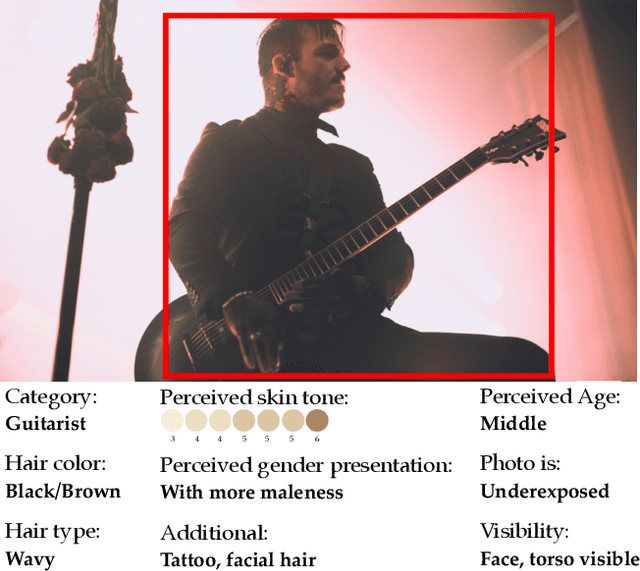
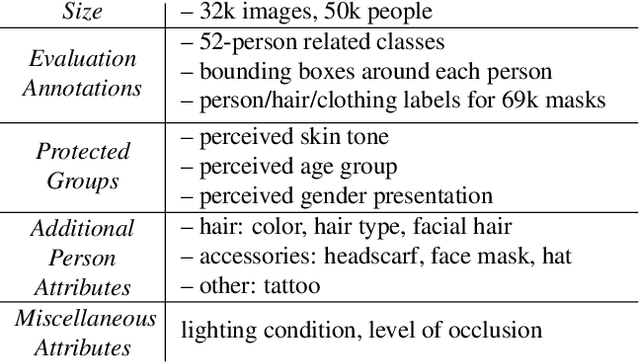

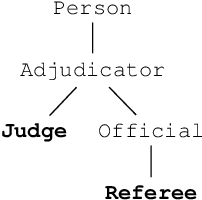
Abstract:Computer vision models have known performance disparities across attributes such as gender and skin tone. This means during tasks such as classification and detection, model performance differs for certain classes based on the demographics of the people in the image. These disparities have been shown to exist, but until now there has not been a unified approach to measure these differences for common use-cases of computer vision models. We present a new benchmark named FACET (FAirness in Computer Vision EvaluaTion), a large, publicly available evaluation set of 32k images for some of the most common vision tasks - image classification, object detection and segmentation. For every image in FACET, we hired expert reviewers to manually annotate person-related attributes such as perceived skin tone and hair type, manually draw bounding boxes and label fine-grained person-related classes such as disk jockey or guitarist. In addition, we use FACET to benchmark state-of-the-art vision models and present a deeper understanding of potential performance disparities and challenges across sensitive demographic attributes. With the exhaustive annotations collected, we probe models using single demographics attributes as well as multiple attributes using an intersectional approach (e.g. hair color and perceived skin tone). Our results show that classification, detection, segmentation, and visual grounding models exhibit performance disparities across demographic attributes and intersections of attributes. These harms suggest that not all people represented in datasets receive fair and equitable treatment in these vision tasks. We hope current and future results using our benchmark will contribute to fairer, more robust vision models. FACET is available publicly at https://facet.metademolab.com/
Pinpointing Why Object Recognition Performance Degrades Across Income Levels and Geographies
Apr 11, 2023



Abstract:Despite impressive advances in object-recognition, deep learning systems' performance degrades significantly across geographies and lower income levels raising pressing concerns of inequity. Addressing such performance gaps remains a challenge, as little is understood about why performance degrades across incomes or geographies. We take a step in this direction by annotating images from Dollar Street, a popular benchmark of geographically and economically diverse images, labeling each image with factors such as color, shape, and background. These annotations unlock a new granular view into how objects differ across incomes and regions. We then use these object differences to pinpoint model vulnerabilities across incomes and regions. We study a range of modern vision models, finding that performance disparities are most associated with differences in texture, occlusion, and images with darker lighting. We illustrate how insights from our factor labels can surface mitigations to improve models' performance disparities. As an example, we show that mitigating a model's vulnerability to texture can improve performance on the lower income level. We release all the factor annotations along with an interactive dashboard to facilitate research into more equitable vision systems.
Segment Anything
Apr 05, 2023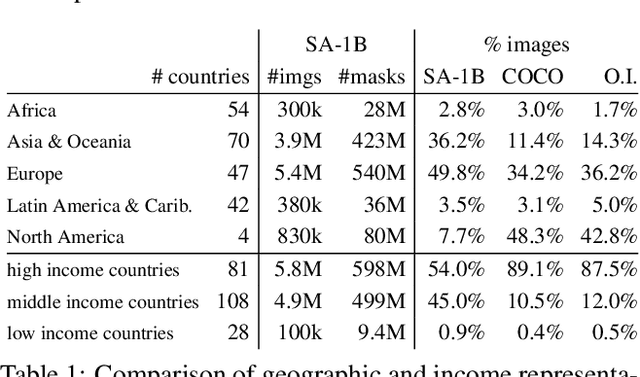

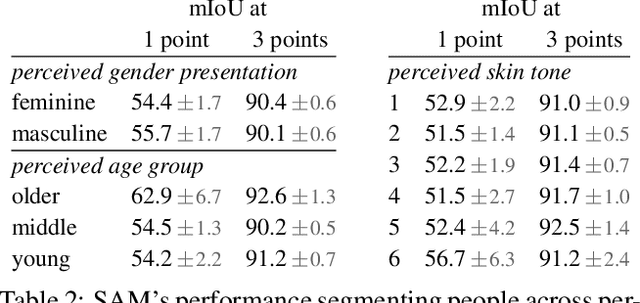

Abstract:We introduce the Segment Anything (SA) project: a new task, model, and dataset for image segmentation. Using our efficient model in a data collection loop, we built the largest segmentation dataset to date (by far), with over 1 billion masks on 11M licensed and privacy respecting images. The model is designed and trained to be promptable, so it can transfer zero-shot to new image distributions and tasks. We evaluate its capabilities on numerous tasks and find that its zero-shot performance is impressive -- often competitive with or even superior to prior fully supervised results. We are releasing the Segment Anything Model (SAM) and corresponding dataset (SA-1B) of 1B masks and 11M images at https://segment-anything.com to foster research into foundation models for computer vision.
Towards Reliable Assessments of Demographic Disparities in Multi-Label Image Classifiers
Feb 16, 2023



Abstract:Disaggregated performance metrics across demographic groups are a hallmark of fairness assessments in computer vision. These metrics successfully incentivized performance improvements on person-centric tasks such as face analysis and are used to understand risks of modern models. However, there is a lack of discussion on the vulnerabilities of these measurements for more complex computer vision tasks. In this paper, we consider multi-label image classification and, specifically, object categorization tasks. First, we highlight design choices and trade-offs for measurement that involve more nuance than discussed in prior computer vision literature. These challenges are related to the necessary scale of data, definition of groups for images, choice of metric, and dataset imbalances. Next, through two case studies using modern vision models, we demonstrate that naive implementations of these assessments are brittle. We identify several design choices that look merely like implementation details but significantly impact the conclusions of assessments, both in terms of magnitude and direction (on which group the classifiers work best) of disparities. Based on ablation studies, we propose some recommendations to increase the reliability of these assessments. Finally, through a qualitative analysis we find that concepts with large disparities tend to have varying definitions and representations between groups, with inconsistencies across datasets and annotators. While this result suggests avenues for mitigation through more consistent data collection, it also highlights that ambiguous label definitions remain a challenge when performing model assessments. Vision models are expanding and becoming more ubiquitous; it is even more important that our disparity assessments accurately reflect the true performance of models.
Vision-Language Models Performing Zero-Shot Tasks Exhibit Gender-based Disparities
Jan 26, 2023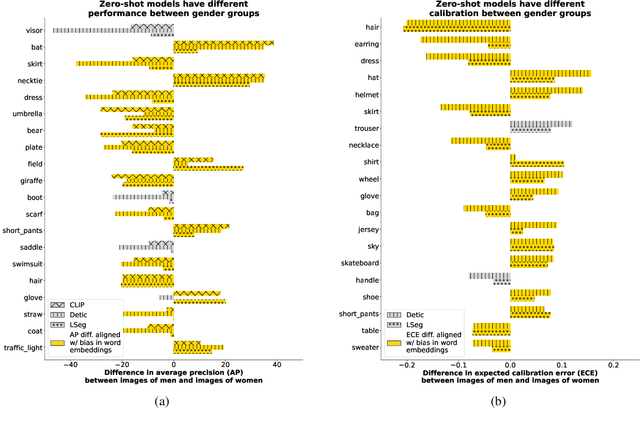

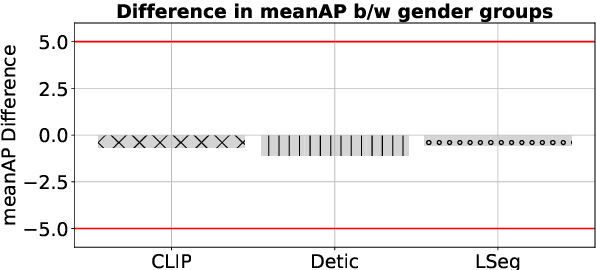
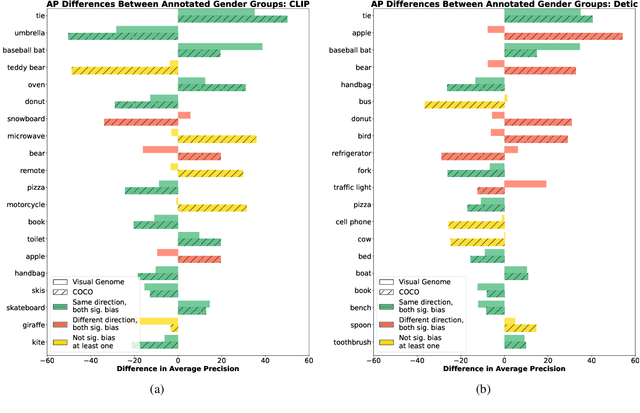
Abstract:We explore the extent to which zero-shot vision-language models exhibit gender bias for different vision tasks. Vision models traditionally required task-specific labels for representing concepts, as well as finetuning; zero-shot models like CLIP instead perform tasks with an open-vocabulary, meaning they do not need a fixed set of labels, by using text embeddings to represent concepts. With these capabilities in mind, we ask: Do vision-language models exhibit gender bias when performing zero-shot image classification, object detection and semantic segmentation? We evaluate different vision-language models with multiple datasets across a set of concepts and find (i) all models evaluated show distinct performance differences based on the perceived gender of the person co-occurring with a given concept in the image and that aggregating analyses over all concepts can mask these concerns; (ii) model calibration (i.e. the relationship between accuracy and confidence) also differs distinctly by perceived gender, even when evaluating on similar representations of concepts; and (iii) these observed disparities align with existing gender biases in word embeddings from language models. These findings suggest that, while language greatly expands the capability of vision tasks, it can also contribute to social biases in zero-shot vision settings. Furthermore, biases can further propagate when foundational models like CLIP are used by other models to enable zero-shot capabilities.
A Systematic Study of Bias Amplification
Jan 27, 2022



Abstract:Recent research suggests that predictions made by machine-learning models can amplify biases present in the training data. When a model amplifies bias, it makes certain predictions at a higher rate for some groups than expected based on training-data statistics. Mitigating such bias amplification requires a deep understanding of the mechanics in modern machine learning that give rise to that amplification. We perform the first systematic, controlled study into when and how bias amplification occurs. To enable this study, we design a simple image-classification problem in which we can tightly control (synthetic) biases. Our study of this problem reveals that the strength of bias amplification is correlated to measures such as model accuracy, model capacity, model overconfidence, and amount of training data. We also find that bias amplification can vary greatly during training. Finally, we find that bias amplification may depend on the difficulty of the classification task relative to the difficulty of recognizing group membership: bias amplification appears to occur primarily when it is easier to recognize group membership than class membership. Our results suggest best practices for training machine-learning models that we hope will help pave the way for the development of better mitigation strategies.
Revisiting Weakly Supervised Pre-Training of Visual Perception Models
Jan 20, 2022



Abstract:Model pre-training is a cornerstone of modern visual recognition systems. Although fully supervised pre-training on datasets like ImageNet is still the de-facto standard, recent studies suggest that large-scale weakly supervised pre-training can outperform fully supervised approaches. This paper revisits weakly-supervised pre-training of models using hashtag supervision with modern versions of residual networks and the largest-ever dataset of images and corresponding hashtags. We study the performance of the resulting models in various transfer-learning settings including zero-shot transfer. We also compare our models with those obtained via large-scale self-supervised learning. We find our weakly-supervised models to be very competitive across all settings, and find they substantially outperform their self-supervised counterparts. We also include an investigation into whether our models learned potentially troubling associations or stereotypes. Overall, our results provide a compelling argument for the use of weakly supervised learning in the development of visual recognition systems. Our models, Supervised Weakly through hashtAGs (SWAG), are available publicly.
Forward Prediction for Physical Reasoning
Jun 18, 2020



Abstract:Physical reasoning requires forward prediction: the ability to forecast what will happen next given some initial world state. We study the performance of state-of-the-art forward-prediction models in complex physical-reasoning tasks. We do so by incorporating models that operate on object or pixel-based representations of the world, into simple physical-reasoning agents. We find that forward-prediction models improve the performance of physical-reasoning agents, particularly on complex tasks that involve many objects. However, we also find that these improvements are contingent on the training tasks being similar to the test tasks, and that generalization to different tasks is more challenging. Surprisingly, we observe that forward predictors with better pixel accuracy do not necessarily lead to better physical-reasoning performance. Nevertheless, our best models set a new state-of-the-art on the PHYRE benchmark for physical reasoning.
PHYRE: A New Benchmark for Physical Reasoning
Aug 15, 2019



Abstract:Understanding and reasoning about physics is an important ability of intelligent agents. We develop the PHYRE benchmark for physical reasoning that contains a set of simple classical mechanics puzzles in a 2D physical environment. The benchmark is designed to encourage the development of learning algorithms that are sample-efficient and generalize well across puzzles. We test several modern learning algorithms on PHYRE and find that these algorithms fall short in solving the puzzles efficiently. We expect that PHYRE will encourage the development of novel sample-efficient agents that learn efficient but useful models of physics. For code and to play PHYRE for yourself, please visit https://player.phyre.ai.
 Add to Chrome
Add to Chrome Add to Firefox
Add to Firefox Add to Edge
Add to Edge